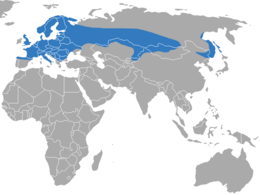Eurasian water shrew
| Eurasian water shrew | |
|---|---|
 |
|
| Scientific classification | |
| Kingdom: | Animalia |
| Phylum: | Chordata |
| Class: | Mammalia |
| Order: | Eulipotyphla |
| Family: | Soricidae |
| Genus: | Neomys |
| Species: | N. fodiens |
| Binomial name | |
|
Neomys fodiens (Pennant, 1771) |
|
 |
|
| Eurasian water shrew range | |
The Eurasian water shrew (Neomys fodiens), known in the United Kingdom as the water shrew, is a relatively large shrew, up to 10 cm (4 in) long, with a tail up to three-quarters as long again. It has short, dark fur, often with a few white tufts, a white belly, and a few stiff hairs around the feet and tail. It lives close to fresh water, hunting aquatic prey in the water and nearby. Its fur traps bubbles of air in the water which greatly aids its buoyancy, but requires it to anchor itself to remain underwater for more than the briefest of dives.
Like many shrews, the water shrew has venomous saliva, making it one of the few venomous mammals, although it is not able to puncture the skin of large animals such as humans. Highly territorial, it lives a solitary life and is found throughout the northern part of Europe and Asia, from Britain to Korea.
The Eurasian water shrew grows to a length of about 10 cm (4 in) long with a tail length of 8 cm (3 in) and weight of 15 to 19 grams (0.53 to 0.67 oz). The dense short fur on the head, back and sides is greyish-black. The underparts are dirty white and are sharply demarcated from the dorsal surface. Sometimes they are tinged with rusty brown or occasionally are entirely dark grey. There is a white spot just behind the eye and often another near the small, rounded ear which is nearly hidden in the fur. The nose is black and the snout long and tapering. The sharp, mostly white teeth are tipped with red, typical of the shrew subfamily Soricinae. The rusty colour comes from deposits of iron which serve to harden the enamel and which are concentrated in the tips of the teeth, particularly the molars which are the teeth most subject to wear. The female has five pairs of nipples. The legs are short and the hind feet are powerful, with a fringe of short, stiff hairs on the outer edge, both of which features assist while it is driving its body through the water. The tail is slender and has a keel of short white hairs on the underside. This shrew often utters shrill cries as it scurries about.
Its karyotype has 2n = 52 and FN = 98.
...
Wikipedia

